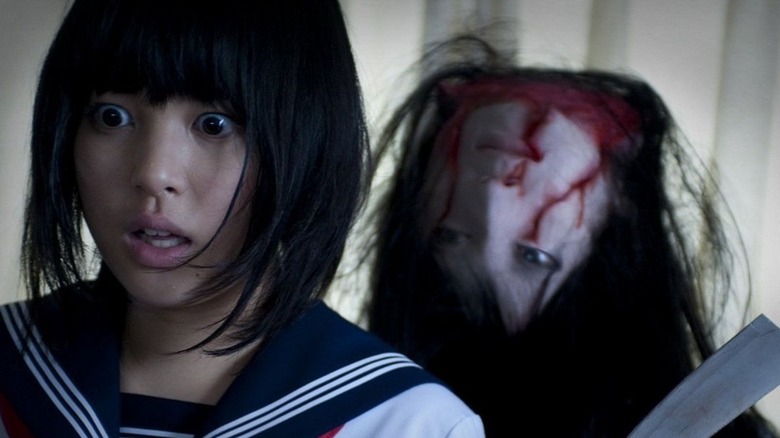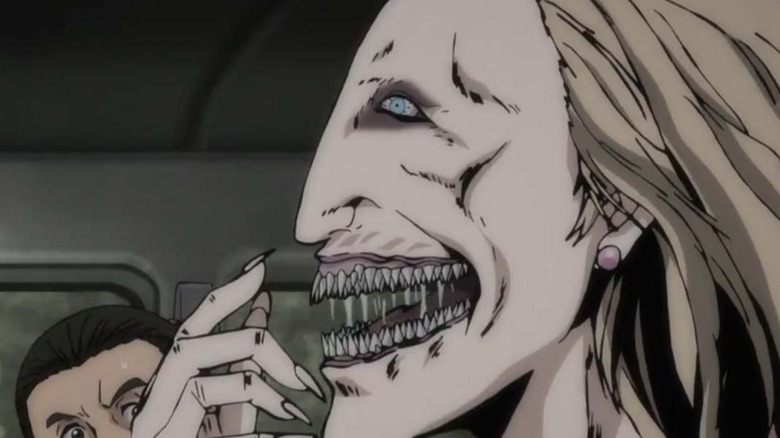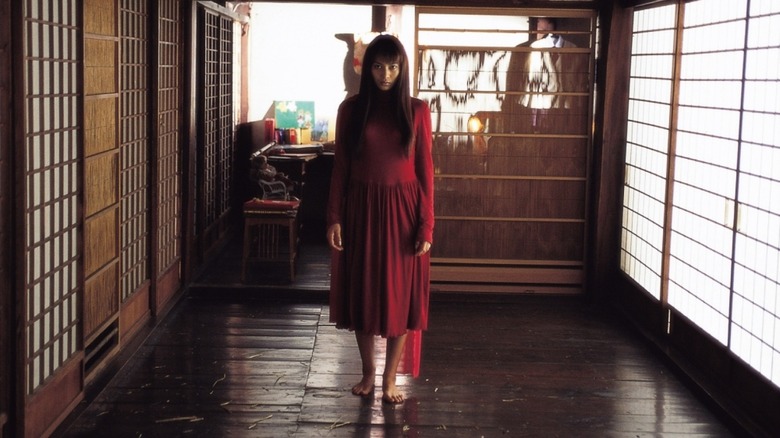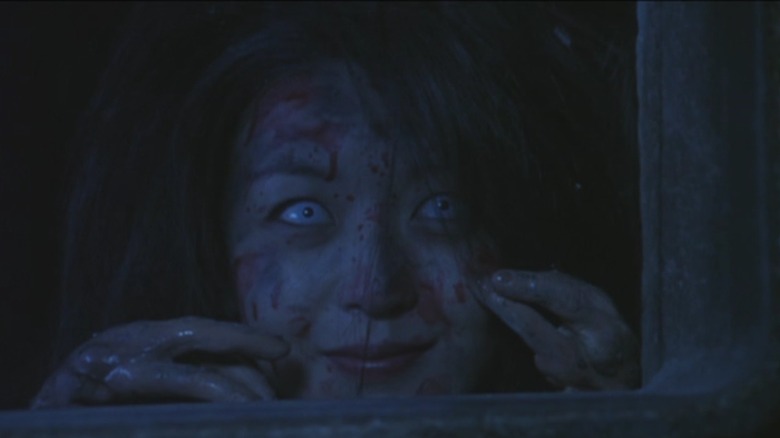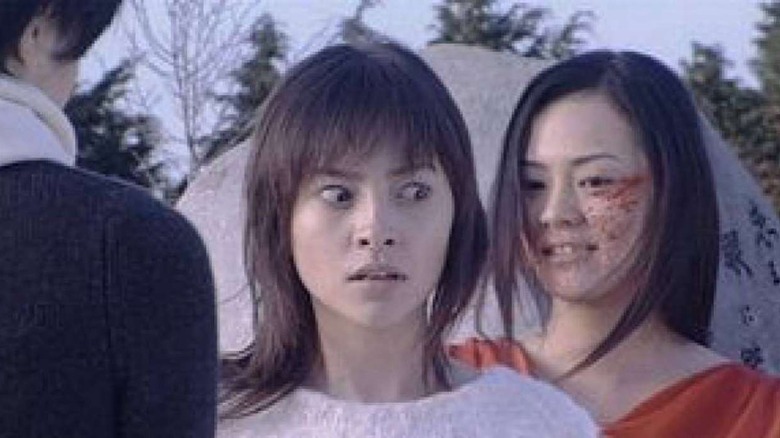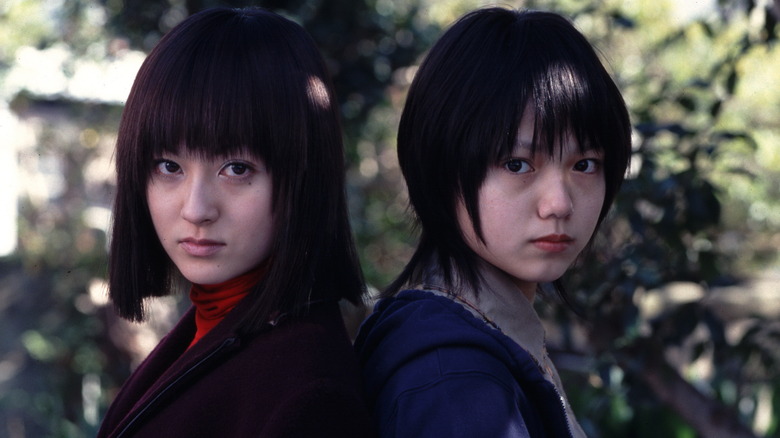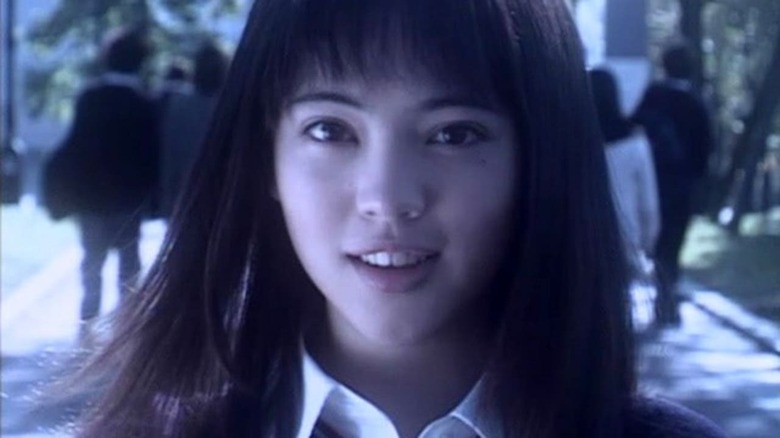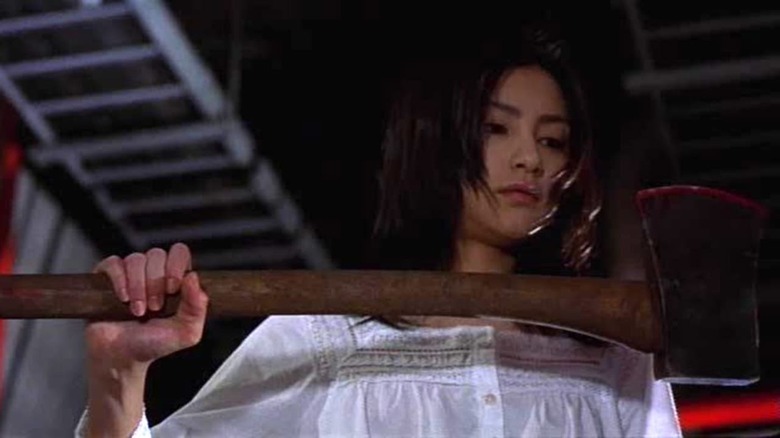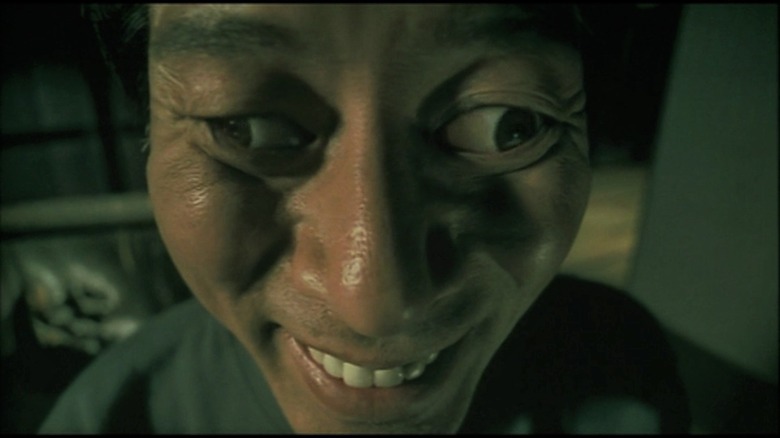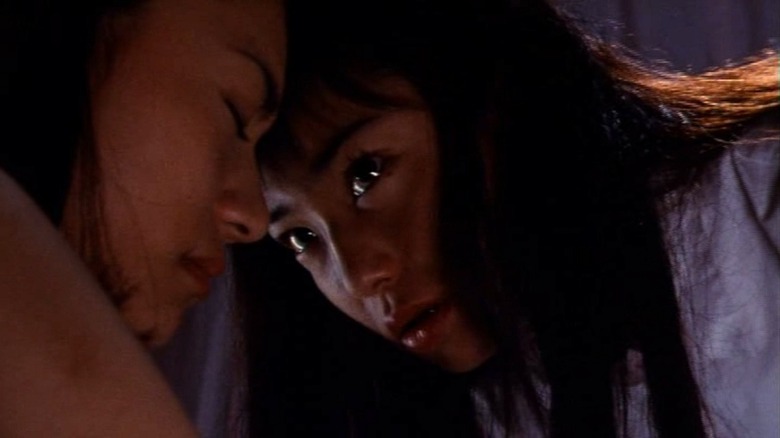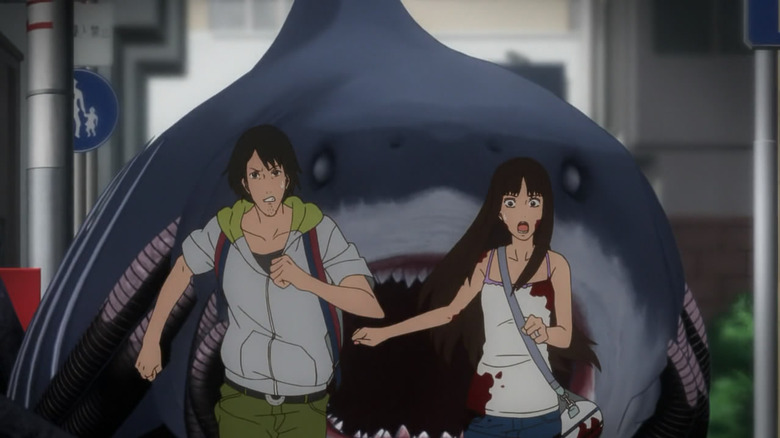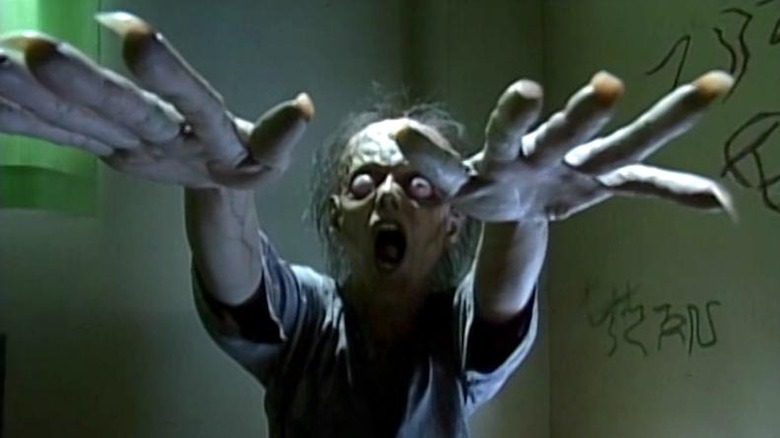The 11 Scariest Junji Ito Adaptations, Ranked
There are things that go bump in the night, campfire stories that leave you shivering, and then there's the work of Junji Ito. Not content to simply give you a brief scare or make the hairs on the back of your neck stand up, Ito's work crawls under your skin and eats you from the inside out, assaulting the imagination with surreal, warped visuals and maddening cosmic horror that would send H.P. Lovecraft himself crying to his mommy. Even the simplest little detail — a song, a chair, the image of a spiral — is twisted into something deadly and unrecognizable. As fans of Ito's work will tell you: There is just nothing else in the world quite like it.
Junji Ito is a mild-mannered master of horror with decades of work and dozens of volumes of horror manga under his belt. So it makes sense that, over the years, other creators have attempted to adapt his dark magic to other mediums. There have been animated anthologies, live-action films, and even an upcoming Adult Swim series. However, adapting Ito's work is no easy task; it can be incredibly difficult to lift his stories and visuals off the page and keep their unique horror intact. Still, that doesn't stop directors and writers alike from trying, and some of them have managed to get pretty close.
So get ready to gaze into the void and have it whisper back its terrible secrets: We're here to rank the scariest adaptations of Junji Ito's work.
11. The Junji Ito Collection (Animated Series)
Some of Junji Ito's best work appears in his short story compilations. They're exquisitely efficient bite-sized bits of horror, pulling you in with just enough detail to make you think you know what's going on ... before pulling the rug out from under you and leaving you disoriented, terrified, and with plenty of unanswered questions to keep you up at night. So, an anthology series adaptation of some of Ito's best short stories seems like a great idea! Enter the 2018 anime, "Junji Ito Collection."
"Junji Ito Collection" features some of Ito's most iconic and disturbing stories, including "Slug Girl," "The Fashion Model," and "Window Next Door." While the content of the stories was left relatively unchanged, many critics were disappointed with how Ito's signature art style was adapted for the anime. The stories themselves are still creepy, but without the grisly detail of Ito's artwork (and the stark contrast of his signature black-and-white color palette), the animated versions feel a bit hollow. It's a nice introduction to Ito's work, but it's also a bit like switching to the diet version of your favorite soda. It's just not nearly as satisfying.
10. Kakashi (Live Action)
"Kakashi" is a film adaptation of one of Junji Ito's famous short stories. Also referred to as "Scarecrow," it tells the story of a young woman named Kaoru who is searching for her missing brother. Believing he left to look for a girl that was once in love with him, Kaoru makes her way to a mysterious small town in the mountains. There, she finds the town to be less than welcoming, as the villagers prepare for a bizarre yearly ritual called "Kakashi."
As she learns more about the town and their traditions, Kaoru learns that the villagers burn human-shaped effigies made of straw in an attempt to draw out the spirits of their dead loved ones and reconnect with them. Of course, because this is a Junji Ito story, it isn't that simple — there's far more going on in this town than meets the eye. Though it's not as scary or bizarre as a number of other Ito adaptations, "Kakashi" has an eerie atmosphere mixed with a classic, creepy small-town setting, resulting in a film that blends Ito's influence with films like "The Wicker Man."
9. Tomie: Re-Birth (Live Action)
One of Junji Ito's most beloved creepy characters is Tomie, a beautiful young woman with a mole under her eye and the power to drive all those around her to madness. Men fall wildly in love with her, overcome by their passion until they are thrown into violent rages, while women become unhealthily obsessed with her in their own right. In each iteration of her story, Tomie is killed, often by a lover, but she can never truly die.
Tomie's influence spreads from person to person like a curse, and she is capable of regenerating — of turning others into copies of her, of possessing people's bodies, and of, horrifyingly, sprouting tiny versions of herself all over her body like tumorous growths. There are nine "Tomie" live-action films so far, and this 2001 installment in the series sees Tomie paired with an artist named Hideo.
After Tomie criticizes Hideo's work on a portrait of her, he murders her and his friends help him dispose of the body. Unfortunately for Hideo and company, Tomie's blood mixed with the paint on the canvas and imbued it with her spirit. Now, she can use the painting to regenerate herself and find a new host body. Though not the best of the "Tomie" films, this one has some decidedly creepy moments and a "Picture of Dorian Gray" flair that sets it apart.
8. Tomie: Revenge (Live Action)
"Tomie: Revenge" is the sixth installment in the film series, and draws its story (and its title) from a specific chapter of the original Junji Ito manga. Ordinarily, "Tomie" stories center around a man who becomes romantically and sexually obsessed with the titular supernatural girl. However, "Revenge" follows a young female doctor named Kazue Kae whose life is thrown into chaos while she is driving down the road alone one night. A strange naked woman unexpectedly darts into the road, and the doctor accidentally hits the said stranger with her car.
In an attempt to track down the almost certainly wounded girl (who she can identify via a mole under her eye), Kazue follows her unintentional victim to an abandoned house. There, she gets far more than she bargained for: The house is filled with dead bodies and, of course, Tomie herself. From there, things only get worse for Kazue, along with anyone else in Tomie's path.
7. Tomie: Forbidden Fruit (Live Action)
This film has two Tomies for the price of one. Not to be confused with "Tomie vs. Tomie," a film in which Tomie literally goes up against another version of herself, "Tomie: Forbidden Fruit" is about two young women both named Tomie. One is an ordinary girl, and the other is our unkillable villainess. This 2002 addition to the film series introduces us to Tomie Hashimoto, a burgeoning young horror writer with few friends and a distant single father. She finds a new companion in Tomie Kawakami, a mysterious beautiful girl with a mole under her left eye.
Unfortunately, this tale of friendship (with heavy sapphic undertones) takes a dark turn as Tomie Hashimoto learns that her new friend sought her out on purpose in order to take revenge on her father. Mr. Hashimoto murdered a version of Tomie years before, and now she has returned to take out her rage on him and his daughter alike. This "Tomie" chapter is tense, unsettling, and paints a rich tapestry of the psychology of love, obsession, and vengeance.
6. Tomie: Another Face (Live Action)
Just like in Junji Ito's manga, Tomie shines as a character when she is explored in a short story format. 1999's "Tomie: Another Face" is not one single narrative, but rather a collection of three separate episodes combined into a feature film. Each episode focuses on Tomie's impact on a different character, with the through-line of a mysterious stalker in a trench coat and eyepatch threaded throughout.
The first episode introduces Tomie as a body found on the street, who comes back from the dead in order to reunite with an old boyfriend. In the second episode, we meet a photographer who has fallen out of love with his craft, only to regain his passion when he meets a beautiful woman at a bar. Considering her his muse, he begins to photograph her without her permission. When he develops the photographs, however, he sees that Tomie has two faces in every single picture: one face is beautiful, and the other is ghoulish and horrible. The third and final episode reveals the identity of the mysterious man with the eyepatch.
These shorter stories allow the action to get straight to the point, and provide several unique depictions of Tomie's wicked, indestructible nature.
5. Tomie: Replay (Live Action)
One of the trademarks of Junji Ito's work is body horror. The human body is twisted to the extreme in his stories — stretched, skinned, dissected, inflated, and transformed almost beyond recognition. "Tomie: Replay" honors this love of distorting the human form, pushing the envelope of an already bizarre film franchise.
Like other "Tomie" stories, this one takes place after a version of Tomie has died. However, in an unfortunate twist for all involved, one of her corpse's organs was used in a transplant. Now, a little girl has a piece of Tomie inside her. When the girl is rushed to the hospital with a massively swollen stomach, operating doctors find Tomie's head growing inside. Turns out that, after the girl received a kidney transplant from Tomie, the organ began to regenerate, head-first ... inside the child's stomach. Employees at the hospital begin to go missing, and a tale of murder and mayhem unfolds from there.
"Tomie: Replay" follows a lot of the usual beats of the "Tomie" films, but the inclusion of Tomie's head growing inside a little girl's stomach like a sentient tumor ups the horror ante in a massive way.
4. Uzumaki (Live Action)
Long before Adult Swim announced its plan for an animated adaptation, Junji Ito's most famous work was pulled off the page and onto the screen. "Uzumaki" starts with two innocuous elements: A small town, and a spiral. Just a location and a shape. But the spiral begins to take hold of the town in a deeply unnatural way, driving its citizens to obsession and paranoia as the world around them begins to twist into a collection of spirals.
Spirals appear everywhere as the story of "Uzumaki" unfolds. A girl's hair curls into one, landmarks tighten into spirals, and parts of people's bodies begin to curve and crunch to fit the shape, too. What follows is a story of paranoia, the destructive nature of single-minded obsession, and a surprisingly complex tale of cosmic horror and the influence of that which we can never understand. It is an incredibly difficult story to adapt, and though the film struggled to capture the visuals perfectly, it is still very much worth the watch. Perhaps the upcoming animated series will learn from the film's mistakes and finally give us an "Uzumaki" adaptation as powerful and stomach-churning as the original manga.
3. Tomie (Live Action)
As is the case with many horror film franchises, the first "Tomie" film is the best, and the scariest. Like "Se7en" and other similar films, "Tomie" marries elements of a gory horror film with a mysterious crime thriller.
As the police work to investigate the murder of a high school girl named Tomie, the victim mysteriously resurrects herself and begins a campaign of bloody revenge against those responsible for her death. At first, this appears to be a rash of suicides, but the truth soon becomes clear when the detective assigned to the case discovers that there have been several murder victims with the exact name, Tomie Kawakami. Not only did these girls share a name, but they were also the same person. Tomie has been murdered, over and over again, since 1860. He tracks down one of Tomie's former classmates, who is being treated for amnesia and has no memory of the period of time around Tomie's death.
"Tomie" is a great mix of supernatural horror and criminal investigation that also serves as the perfect entry into the wild world of a legendary horror villain.
2. Gyo (Animated Film)
Another one of Junji Ito's most famous stories is "Gyo," a two-volume manga that first appeared as a weekly serial in the magazine Big Comic Spirits. "Gyo" is an apocalyptic horror story that, at times, feels evocative of some of the best zombie films. However, "Gyo" should not be mistaken for a common zombie apocalypse story. No, it is far stranger than that.
In "Gyo," a young couple named Tadashi and Kaori must fight for their lives as thousands of undead fish come ashore, propelling themselves with spindly metal legs powered by something called the "death stench." The concept sounds like it could be silly, something out of a B-movie like "Sharknado," but "Gyo" threads the fine line between absurdity and terror beautifully. The dread and mystique of the deepest, darkest parts of the ocean come ashore, and humanity is completely unprepared for the threat. Oh, and it also features one of the scariest sharks since "Jaws."
2012 saw the release of an anime film entitled "Gyo: Tokyo Fish Attack" or, simply, "Gyo," which tells the story of the manga in a tight 70 minutes, keeping the fast-paced, frantic nature of the original.
1. Long Dream (Live Action)
Junji Ito stories have a way of lingering with the reader long after they've turned the final page. The images are nightmarish, but the strength of the work also lies in its psychological impact. Routinely, Ito's work introduces a concept that becomes more frightening the longer you think about it, encouraging your imagination to run with the idea and terrify itself. There is perhaps no better example of this lasting effect than "Long Dream."
The film begins with a man checking into a hospital, complaining of trouble with his dreams. Whenever he goes to sleep, his dreams stretch for a longer and longer amount of time. Though to outside observers he appears to be sleeping for only a night, he is living out years of time in the dream world. He begins to experience extreme anxiety about going to sleep, knowing that the dreams will become longer and longer. As they do, his grip on reality loosens, as does his resemblance to anything remotely human. This made-for-tv adaptation of the story brings its most gruesome panels to life, and poses the question: What is the difference between an infinite dream, and death itself?
